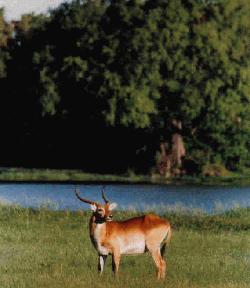Red Lechwe - Kobus leche
 As a result of its amphibious habits, the lechwe is preyed on by a variety of predators, from crocodiles and pythons to lions, leopards, spotted hyaenas and wild dogs. Like the reedbuck, it sometimes flattens itself on the ground to avoid detection, suddenly taking off in startled leaps and bounds. Lechwe may congregate in hundreds or thousands, although most herds number about 20-30 individuals. Lechwe easily become habituated to human presence and are often seen close to lodges in the Okavango Delta wehre, in some cases, they even seek refuge from predators by sheltering under the floodlights of the lodge. Visitors to Khwai River Lodge and Tsaro, while enjoying their dinner, have often been treated by the sight of lechwe fleeing from a pride of hunting lions.
As a result of its amphibious habits, the lechwe is preyed on by a variety of predators, from crocodiles and pythons to lions, leopards, spotted hyaenas and wild dogs. Like the reedbuck, it sometimes flattens itself on the ground to avoid detection, suddenly taking off in startled leaps and bounds. Lechwe may congregate in hundreds or thousands, although most herds number about 20-30 individuals. Lechwe easily become habituated to human presence and are often seen close to lodges in the Okavango Delta wehre, in some cases, they even seek refuge from predators by sheltering under the floodlights of the lodge. Visitors to Khwai River Lodge and Tsaro, while enjoying their dinner, have often been treated by the sight of lechwe fleeing from a pride of hunting lions.
The ram will defend his territory with threatening displays, and will fight if an intruder tries to mate with one of his ewes. The clash of horns during these fierce, sometimes fatal, duels may be heard a long distance away. Calves can be born at any time of year. Cows leave the herd to give birth and hide their newborn calves for two to three weeks in the shelter of reeds on an island or other dry spot. Calf mortality is high: usually about 50%.







